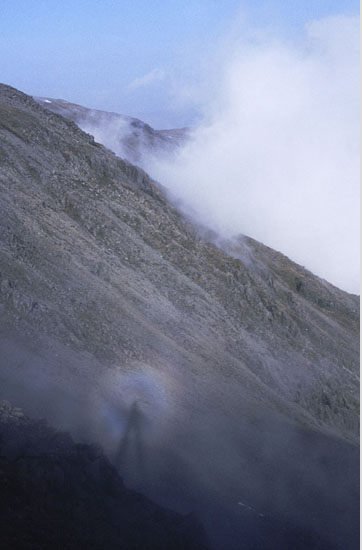Brocken Spectre
The Enigmatic Brocken Spectre: Exploring an Atmospheric Optical Phenomenon
Have you ever found yourself hiking through misty mountains or thick fog and noticed a peculiar shadowy figure seemingly projected onto the clouds? This intriguing phenomenon, known as the Brocken Spectre, has fascinated and puzzled observers for centuries. Named after the Brocken, the highest peak in the Harz Mountains of Germany, where it was first documented, this optical illusion occurs when sunlight interacts with mist or clouds, creating a stunning and ethereal spectacle. In this article, we will delve deeper into the captivating world of the Brocken Spectre and uncover its secrets.
The Formation of the Brocken Spectre
The Brocken Spectre is created through a combination of sunlight, mist, and the observer's position relative to these elements. When sunlight shines from behind the observer, their shadow is cast onto the mist or clouds ahead. Due to the scattering of light by water droplets in the mist or clouds, the shadow appears magnified, often surrounded by a halo-like ring of colors. This creates the illusion of a larger-than-life figure with an ethereal glow, seemingly suspended in the air.
Exploring the Science Behind the Illusion
To understand why the Brocken Spectre appears magnified, we must delve into the science of optics. When sunlight passes through tiny water droplets in the mist or clouds, it undergoes a process called diffraction. This causes the light to spread out and bend, creating a phenomenon known as the glory. The glory is a circular band of colors that surrounds the observer's shadow in the Brocken Spectre. The size of the glory is determined by the size of the water droplets, with larger droplets producing a larger glory.
A Play of Light and Shadows
The atmospheric conditions required for a Brocken Spectre to occur are quite specific. Firstly, there must be a source of sunlight behind the observer, such as the sun rising or setting. Secondly, there must be a sufficient amount of mist or clouds in the air to scatter the sunlight. Lastly, the observer's position must be such that their shadow is projected onto the mist or clouds. These conditions align only rarely, making the Brocken Spectre a relatively rare and elusive phenomenon.
Capturing the Elusive Beauty
Photographing a Brocken Spectre can be a challenging endeavor due to its transient nature. However, with the right conditions and equipment, it is possible to capture this captivating optical illusion. A camera with a telephoto lens can help magnify the spectacle, while adjusting the exposure settings can enhance the colors of the glory. Patience and persistence are key, as one must wait for the perfect alignment of sunlight, mist, and shadow to capture the Brocken Spectre in all its glory.
Cultural Significance and Folklore
Throughout history, the Brocken Spectre has captivated the imagination of those who have witnessed it. In folklore and mythology, this phenomenon has often been associated with supernatural beings or mythical creatures. The Brocken, where the phenomenon was first observed and named, holds particular significance in German folklore, as it is believed to be a gathering place for witches and spirits. Today, the Brocken Spectre continues to inspire awe and wonder, serving as a reminder of the mysterious beauty of our natural world.
Unraveling Nature's Illusions
The Brocken Spectre is just one example of the many fascinating atmospheric optical phenomena that occur in our skies. From rainbows and halos to mirages and sun pillars, these illusions remind us of the intricate interplay between light, air, and moisture in our atmosphere. By studying and understanding these phenomena, scientists can gain valuable insights into the behavior of light and its interaction with our environment.
In conclusion, the Brocken Spectre is a mesmerizing atmospheric optical phenomenon that enchants and bewilders observers. Created through the interplay of sunlight, mist, and shadows, this elusive illusion presents itself as a larger-than-life figure surrounded by a halo-like glory. With its rarity and ethereal beauty, the Brocken Spectre serves as a reminder of the mysterious wonders that await us in the natural world. So, the next time you find yourself amidst misty mountains or dense fog, keep an eye out for this enchanting spectacle, and perhaps you will witness the elusive Brocken Spectre in all its magnificence.

Another Spectre in bright light from thin mist by Ken Scott (Touching The Light).
"April 1995 looking across Black Combe from Red Pike to Pillar in the .English. Lake District, mid afternoon on an otherwise normal and warm day for early spring."
Compare the glory diameter with that of the Snowdonia image. Both were taken with a 50mm lens. The mist droplets forming this Lake District glory were much larger.
©1995, 2002 Ken Scott, All rights reserved.
Note: this article has been automatically converted from the old site and may not appear as intended. You can find the original article here.
Reference Atmospheric Optics
If you use any of the definitions, information, or data presented on Atmospheric Optics, please copy the link or reference below to properly credit us as the reference source. Thank you!
-
<a href="https://atoptics.co.uk/blog/brocken-spectre-3/">Brocken Spectre</a>
-
"Brocken Spectre". Atmospheric Optics. Accessed on November 26, 2024. https://atoptics.co.uk/blog/brocken-spectre-3/.
-
"Brocken Spectre". Atmospheric Optics, https://atoptics.co.uk/blog/brocken-spectre-3/. Accessed 26 November, 2024
-
Brocken Spectre. Atmospheric Optics. Retrieved from https://atoptics.co.uk/blog/brocken-spectre-3/.